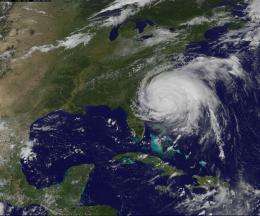Forecasting the fallout from natural disasters

When Hurricane Irene barreled up the East Coast this August, forecasters had a pretty good idea of the track the storm would take, along with its expected wind, rain and storm surge.
Determining how the storm's meteorological force would impact the Eastern Seaboard's energy system and other critical infrastructure, however, required additional analysis.
To answer this question, officials at the U.S. Department of Energy's (DOE) Office of Electricity Delivery and Energy Reliability tasked researchers at Argonne National Laboratory's Infrastructure Assurance Center (IAC) with estimating how the oncoming storm would affect certain key energy infrastructures—electrical transmission, natural gas supply and petroleum pipelines.
In their analysis, the IAC researchers determined that millions on the Eastern Seaboard likely would be left without power, some potentially for weeks. Using a storm track provided by the National Oceanic and Atmospheric Administration, they determined state-by-state which utilities were likely to be hardest hit.
While Argonne engineer Steve Folga and his colleagues in the IAC provided only pre-event analysis in the case of Hurricane Irene, they have also collaborated in the past on providing information during and after storms and other natural disasters.
"When you get into the trans-event analysis, you're really trying to monitor a lot of real-time information," said IAC director Jim Peerenboom. "During an event, the DOE spends a lot of time talking to owners and operators of petroleum refineries, transmission and distribution companies, and pipelines trying to collect valuable information as to whether and when they will be operational."
The IAC's work in the past has extended beyond analyses of the energy infrastructure alone. In previous events, the IAC has investigated what Peerenboom calls "interdependencies," or the ways in which a regional energy network interacts with other systems, like municipal water supplies, transportation or the financial sector.
"There are all kinds of impacts that we've looked at in the past as part of other programs," Folga said. "We have to move beyond the energy infrastructure because if electricity is out or petroleum pipelines are affected, it could imperil a whole host of other critical networks during the course of the event."
Pre-event modeling, like the type done in the lead-up to Hurricane Irene, can also tell only so much of the story, according to Folga. No matter which organization is handed the responsibility of investigation for the duration and aftermath of the event, scientists need to pool the information gathered in each time frame to create a more comprehensive picture of how the country's infrastructure responds to adversity. "When we or others do trans-event analysis, we need to also monitor those real-time results to see how they match our predictions," he said.
Provided by Argonne National Laboratory



















